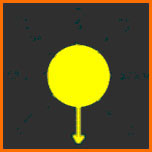A ledtechnika fogalmai:
Fundamental conceptions
| Light Human eye can perceive as visible light electromagnetic radiation of 380-780 nm wavelength. But our organ of sight is not sensitive equally to different wavelenght radiations and for this reason different Luminosity functions concern sight if it is daylight, and sight in the dark. Lighting technology takes as its basis Luminosity function in daylight, its symbol is V (lambda), Luminsoity function's symbol in dark is symbol V'(lambda). |
 |
| Luminous flux Luminous flux is the perceived power of light measured by luminosity that a light source emits in every space direction. |
 |
| Luminous intensity is a part of luminous flux emitted in one particluar direction (solid angle) of space. |
 |
| Illuminance Illuminance is the quantity of luminous flux incident on a surface emitted by a light source. |
 |
To illuminate a place 100 lux is enough, but you ought to supply 300 lux to illuminate a table.  |
 |
| Luminance Unit: 1 candela/m2 (cd/m2) |
 |
| Luminous efficacy Light sources's important characteristic. Lighting's efficacy. A light source's ratio of total luminous flux to total radiant power. |
 |
| Color temperature Apart from luminous intensity emitted by light sources, color temperature is a determinative factor. Artificial light sources's color are considered neutral from 3300 K to 5300 K, lower color temperatures than 3300 K are warm, and higher color temperatures from 5500 K are cool colors. Example: normal incandescent bulb's filament has 2800 K, and night sky is higher than 6000 K. |
 |
